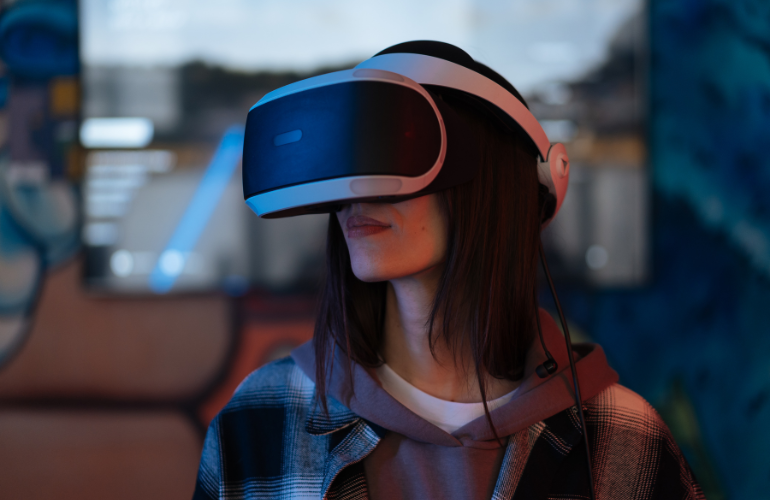Augmented reality has gained rapid acclaim as a captivating entertainment medium, highlighted by the success of Pokemon Go, Snapchat filters, and various video games. However, as we enter 2024, augmented reality transcends its initial role and emerges as a formidable business tool.
The integration of Augmented reality (AR) is orchestrating a revolution in marketing. AR unlocks previously deemed futuristic marketing strategies by merging the digital and physical realms. Notable examples include IKEA’s AR app, which allows customers to see furniture in their homes virtually. Another example is Sephora’s AR tool, which helps customers try on makeup through a virtual experience. These instances showcase the transformative power of this immersive technology, reshaping the marketing landscape in ways that marketers are only beginning to explore.
Augmented reality is no longer confined to entertainment. It has evolved into a versatile and impactful tool for businesses to engage with their audience and enhance marketing strategies.
Marketing Impacts And Potential
For those exploring innovative applications of AR, there are numerous opportunities and options to try. The transformative use of AR within marketing shows how this technology is reshaping strategies and creating unique brand experiences.
Customer Experience
Augmented reality reshapes the landscape of marketing experiences, seamlessly blending imagination with reality to create interactive moments that captivate users and engage your audience. The first encounter with an AR-enabled experience evokes a sense of wonder, surprise, and joy, often generating positive responses from most users.
AR is instrumental in making personalized marketing a tangible reality. Creative campaigns utilize AR to offer users unique virtual experiences, allowing them to participate and actively shape their interactions. This dynamic approach to marketing caters to individual preferences, providing users with a more tailored experience.
Enhanced Storytelling
Augmented reality can enhance storytelling and create immersive brand experiences. Unlike traditional forms of storytelling, AR allows marketers to break the barriers of two-dimensional narratives and bring stories to life in three-dimensional, interactive spaces. By integrating AR elements into marketing campaigns, brands can captivate their audience with narratives that unfold seamlessly within the users’ physical surroundings.
Incorporating AR into storytelling introduces an interactive layer where consumers participate in the narrative. Brands can leverage AR to superimpose virtual elements onto the real world, providing users a personalized experience. For example, an AR-enabled product launch could feature a virtual guide narrating the brand’s journey, with interactive elements appearing as users explore the story through their smartphones or AR glasses.
Moreover, AR allows for immersive storytelling experiences that transcend the limitations of traditional media. Brands can use AR to build virtual environments, introducing characters and scenarios seamlessly blending with users’ surroundings. This sparks curiosity and establishes a deeper emotional connection between the audience and the brand.
The dynamic nature of AR storytelling enables marketers to adapt content based on user interactions, ensuring a more relevant experience. Whether unveiling hidden layers of a story or allowing users to manipulate virtual objects, AR empowers brands to build narratives to individual preferences, fostering a sense of connection to the story.
Brand Awareness And Visualization
One advantage of AR in marketing campaigns is its ability to generate heightened awareness and buzz around products. By using AR experiences in promotional materials or advertisements, brands can capture the attention of their target audience in unique and interactive ways. For instance, interactive AR filters on social media platforms enable users to try out products virtually. Filters can create a fun and shareable experience that spreads organically across social networks. This enhances brand visibility and fosters a sense of consumer excitement.
Product visualization is another area where AR proves to be a game-changer in marketing. Traditional methods of showcasing products through static images or videos can fall short of conveying a comprehensive understanding of the product’s features or fit within a consumer’s life. AR allows customers to see products in their own environment using smartphones or AR-enabled devices.
This immersive experience enables potential buyers to interact with virtual representations of the product, exploring details from different angles and gaining a more accurate sense of its size, design, and functionality. As a result, AR reduces uncertainties in the purchase decision-making process, enhances customer confidence, and potentially increases conversion rates.
Moreover, AR-powered marketing campaigns create a sense of novelty and innovation, reinforcing a brand’s image as forward-thinking and technologically savvy. As consumers increasingly seek engaging and personalized interactions with brands, AR provides a dynamic platform for marketers to create memorable and shareable experiences that resonate with their target audience. This helps foster brand loyalty and long-term customer engagement.
2024 Trends
The dynamic evolution of AR technology presents a fast-paced and challenging landscape due to its ever-improving tools and advancements. Staying informed about recent trends not only aids businesses in navigating the swiftly progressing technology but positions them to capitalize on emerging trends at their inception.
AI and AR
Artificial intelligence and augmented reality have long intertwined in their development. AI models exhibit superior efficiency in tasks such as face and room scanning, surpassing the capabilities of human-written algorithms. In 2024, the landscape of augmented reality technology is evolving beyond mere reliance on AI for interpreting sensor data. Several crucial tasks demonstrate how AI supplements and elevates AR experiences.
One significant advancement lies in building realistic human models and object scans. Thanks to artificial intelligence, AR has improved the delicate analysis of key facial points to reconstruct faces and objects into lifelike 3D models. These models serve as avatars or assets within virtual environments, transforming the depth and realism of AR interactions.
Another pivotal role of AI in augmented reality is object detection and labeling through machine vision. This capability allows AI to identify and label real-world objects, facilitating more than mere recognition. Virtual objects can be seamlessly overlaid onto the physical world, enhancing AR interactions and user experiences.
Text recognition and translation represent another improvement. Users can effortlessly point their cameras at a text, allowing AI-powered systems to translate it in real-time, providing a seamless bridge between the physical and virtual realms.
The recent surge in generative AI models, exemplified by innovations like Chat-GPT, holds significant promise for the future of AR. Tools already harness natural language processing and generative AI to create and manipulate 3D objects. This extends beyond shapes, encompassing textures, animations, and a myriad of possibilities that usher in a new era of AR experiences advanced by the capabilities of generative AI models.
Mobile AR Tools
Mobile augmented reality tools have transitioned from simple, entertaining gadgets to indispensable assets for crucial tasks like navigation and scene analysis. Businesses are leveraging mobile AR more than ever, incorporating it into various operations such as remote assistance, training programs, product visualization, and more.
In mobile AR advancements, Google’s ARCore takes center stage with its 2022-2023 updates. Evolving its Android augmented reality technology, ARCore introduces innovative features like Streetscape Geometry, providing developers with access to building and terrain geometry within a 100-meter radius. Rooftop anchors further enhance the experience by allowing digital objects to be anchored to building rooftops using actual height and geometry references. Google extends the reach of ARCore by making scene semantics API available on iOS devices, positioning it as a leading cross-device augmented reality platform.
On the iOS front, Apple’s ARKit 6 emerges as a competitive player in the augmented reality arena. Boasting features like LiDAR scanner depth API, instant AR powered by LiDAR sensor’s plane detection, 4K video recording during ARKit sessions, motion and pose capture, and location anchors for new areas like Sydney, Montreal, Toko, and Singapore, ARKit 6 stands at the forefront of innovation. One notable enhancement is RoomPlan. This tool leverages the LiDAR scanner to create floor plans rapidly, forming the basis for AR measurement tools on Apple devices.
As ARKit and ARCore evolve, the mobile AR landscape is poised for even more transformative developments.
Wearable AR Devices
The wearable augmented reality industry has undergone significant transformations in recent years. Apple finally unveiled its long-anticipated AR/VR headset, the Apple Vision Pro. Despite its sizable price point, this announcement signifies a milestone on the journey towards consumer-grade augmented reality headsets.
A central theme in wearable augmented reality revolves around generating screens and utilizing computer applications from anywhere. Alternatively, users can enjoy a cinematic experience from their homes on a large virtual screen. As augmented reality headsets propel us into a new era of interfaces, integrating spatial computing becomes imperative for a natural and intuitive interaction with these devices.
Simultaneously, Meta has introduced the Quest 3 and Quest Pro. These feature full-color pass-through capabilities, making augmented reality functionalities more accessible and affordable. Noteworthy among Meta’s offerings is the introduction of PianoVision as a mixed reality feature for the Meta Quest 3. This innovative app assists users in learning to play the piano. It incorporates Synesthesia-style 3D notes or traditional sheet music, with labeled keys providing additional support for beginners. These advancements highlight the diverse and evolving landscape of wearable augmented reality experiences as significant players in the industry continue to push the boundaries of technology.
Future Trajectories
Various augmented reality applications in the marketing industry offer innovative ways to elevate experiences. Transforming traditional elements such as business cards, user manuals, and product demonstrations into immersive AR experiences has become a compelling strategy for businesses aiming to distinguish themselves in a competitive landscape.
The impact of augmented reality technology on marketing is not just experiential; it’s also financially rewarding. According to AR Insider, AR’s anticipated global revenue is projected to reach around $39.8 billion by 2027. The integration of AR into marketing strategies has proven successful across various platforms, with AR lenses popular on platforms like Snapchat and Meta leading the way. Snap AP, in particular, stands out due to its organizational focus, high levels of lens engagement, and effective monetization per user.
TikTok is another formidable player in the AR realm, leveraging its massive user base and relatively recent AR platform. Visual search, where users point their phones at products for identification, is poised to gain prominence in the coming years. This practical and frequently used feature aligns with natural monetization strategies, akin to the evolution of web search functionality. As AR technology continues to evolve, the marketing landscape stands to benefit from both enhanced user engagement and significant revenue growth.
Marketing Ahead of The Curve
Not all businesses can afford to focus on marketing trends and keep up with constantly changing technology. That’s where Payani Media can help. At Payani Media, we aim to empower companies to reach new heights and become industry leaders. Fueled by innovation and guided by expertise, we stand as a catalyst for overcoming challenges and unlocking opportunities.
Our team embraces a culture of excellence, where continuous improvement and high standards drive exceptional results. Through synergistic achievement, we merge high individual performance with a collaborative spirit, propelling us toward remarkable outcomes. Reach out today to learn more about where you can take your business with the proper marketing support.




